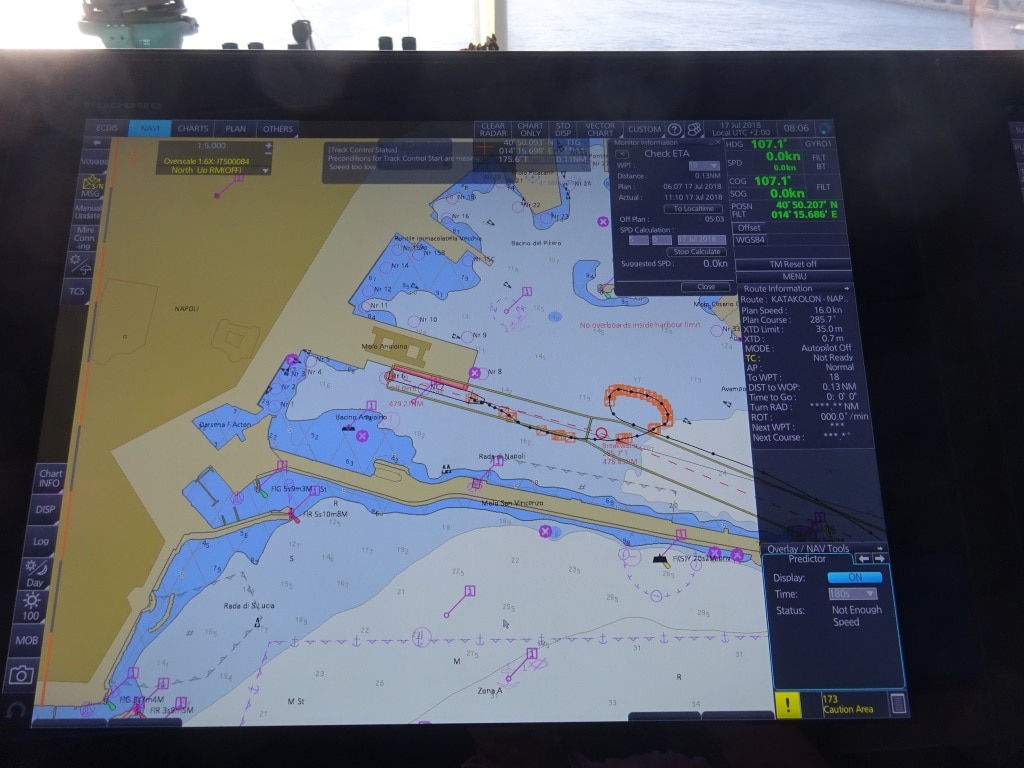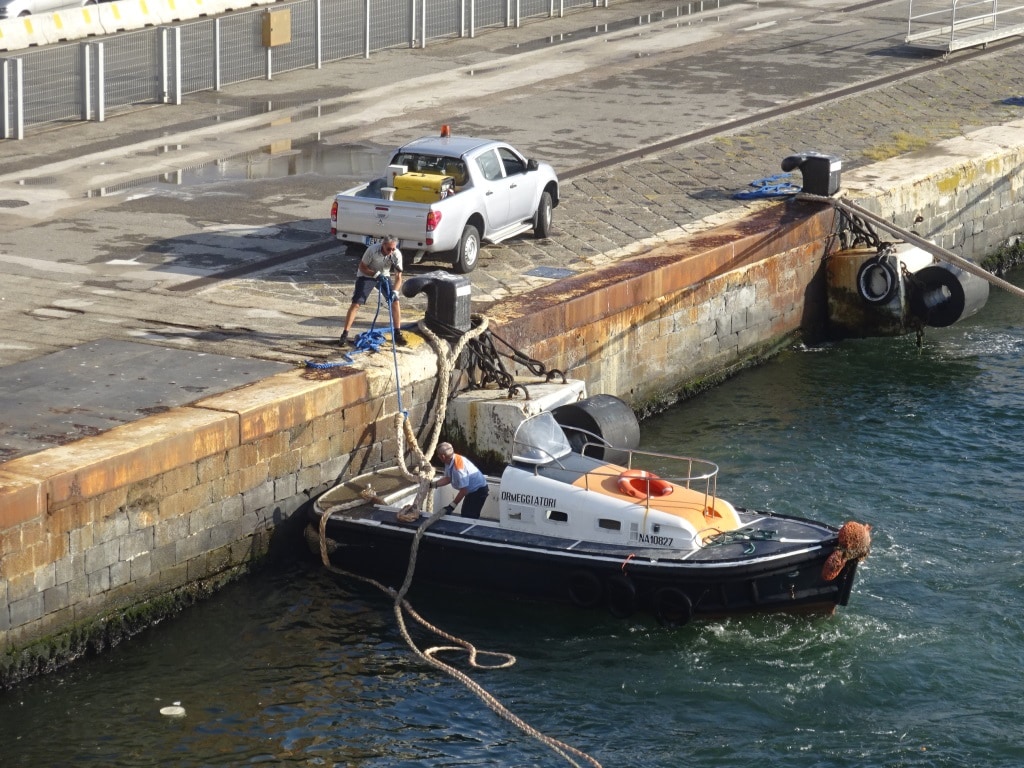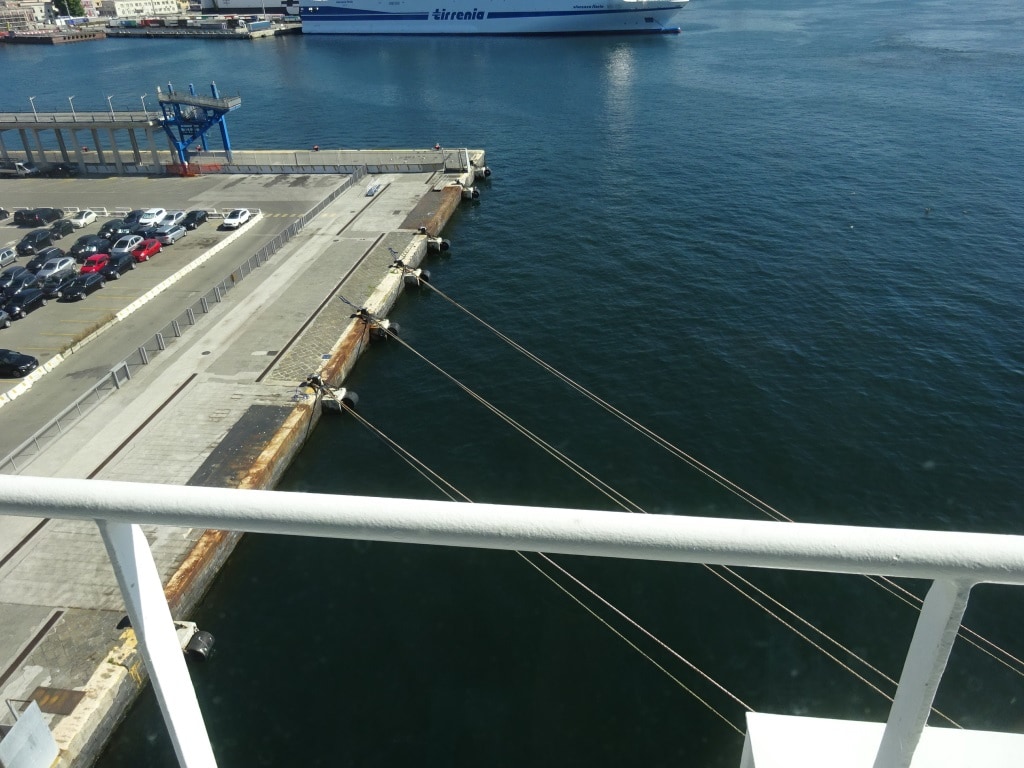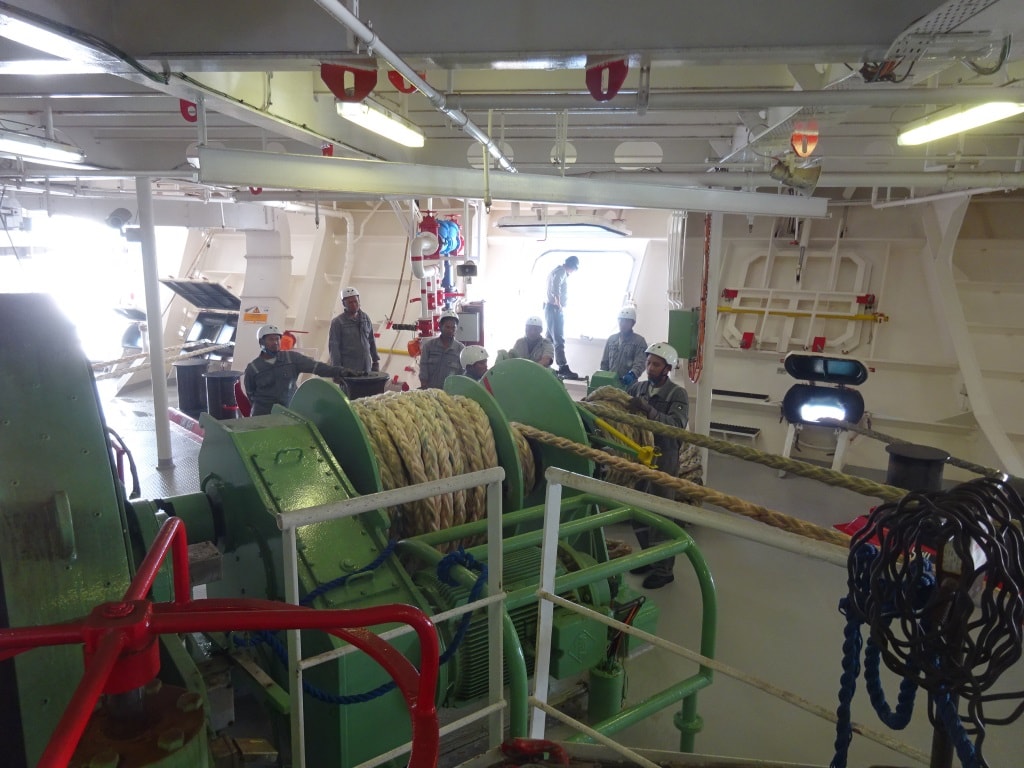The weather front was much slower in passing by than had been forecast and the rain predicted for the very early morning hours was still lingering over the sea when we approached. All the dark clouds did disappear very quickly though while we were docking and the remainder of the day was sunny and very warm. Not so bad when you are on tour but a challenge if you decide to walk through the narrow streets in the old city. For the rest Naples was itself today with a lot of city noise, caused by cars and mopeds but also by the Neapolitans themselves who only seem to be able to communicate at the top of their voices, even when having a normal conversation. They say the people of Napoli live on the streets and I can understand why; the wife kicks them all out of the house as they are making way too much noise.

It is traditional that the ships dock noise out in Naples. On arrival in the morning it is normally wind still which makes it much easier then for departure to get out of the port.
I was forward with one of the cadet this morning. In the past few days I have guided both of them through anchoring, docking and undocking. The last few ports were simple ones, straightforward with the mooring lines and the only thing he had to do was passing on the right information between Bo ‘sun and Bridge and monitoring the safe working practices of the sailors. Today the challenge was upped a little bit here in Napoli. Because we are much too big for a cruise terminal (constructed for the “large” ships of the 1930’s) and because the Norwegian Epic had the long berth on the East side, we were sticking out by about 50 meters. That meant that all the lines were running aft to the dock and to get the lines ashore you get a local line boat. We do not like all our lines running aft as it means that there is nothing to hold the bow if a cross beam wind would suddenly blow up. Our plan B is then to drop the anchor and/or call a tugboat.

The Ormeggiatori, or linesmen using a powerful skiff to bring the mooring lines ashore.
Thus this morning the cadet had to keep oversight, communicate, direct the lines, yell at the Ormeggatiori (linesmen in the boat) and ensure that the sailors were not doing things too fast. Not easy if you have to do this without any previous experience. Luckily the Bo ‘sun is an experienced man and as backup I was hovering “benevolently” in the background. The tricky thing in this port is that the lines are very long as we are hanging over so far. So we have to pay out a lot of rope; rope that is then pulled ashore by the lines boat. If you do not pay out the mooring line fast enough, the linesmen will yell, if you pay out too much (too much spaghetti in the water), it slows down the boat and the linesmen will yell, and if you have not set things up properly, the sailors will yell. (Naples is a real good port for yelling…… ……. Everybody does it.

This was the end result. Six long lines which are normally running forward as head lines and two spring lines (not visible) which were running their regular way. We normally call this 6 and 2. Now it was more 0 and 8, but then there was no other option.
The solution to the challenge is, to first instruct the deck team in detail what is going to happen and how you want it done. Invite the Bo ‘sun to give his input as he has a lot of experience and then decide on the plan. 2nd step is to run out the ropes on an even pace that can be handled by the lines boat and also works for the sailors who guide the ropes of the mooring drums. In the meantime you have to keep up your reports to the bridge as they want to know what you are doing and how you are progressing. The bridge can see where the blow ropes are going but not the status of the belaying on the mooring deck.

This is one of the more dangerous moments during docking. The belaying of the “extra rope” on the capstan. An extra rope does not have its own mooring drum and is handled completely by hand. As it can slip from the capstan, the guiding work is done by one sailor while the rest keeps out of the way until the rope is tight and safe on the capstan.
In the end it was real team work, the cadet communicated, the Bo; sun kept the oversight and I did the yelling. When we came back upstairs to report back to my colleague, he paid the cadet a compliment because it went so smooth and so fast. (It was of course the yelling that did it but we did not say that…..)
This afternoon the good ship ms Oosterdam sails for Civitavecchia. This is a regular port of call tomorrow and not a turn around day, which we often have here. Nearly everybody is on some sort of tour, either to Rome or in the area around the port. I will be leaving the ms Oosterdam and fly from Rome via Amsterdam to Stavanger to join the ms Koningsdam. I will join on the 20th. so for two days there will be no blog. I have to wait a day for the Koningsdam to catch up with me; but I have a hotel in the center of the city, opposite the cruise terminal, and there is a hop on / hop off bus so I will be set.

July 18, 2018 at 4:14 am
Thanks Captain Albert for writing your daily blog, it is truly interesting to get this insight into what happens “behind the scene”.
Especially interesting with detailed descriptions like today about handling the mooring lines.
Again, thank you and look forward to your return after the short break.